The Apple iPad Review (2012)
by Vivek Gowri & Anand Lal Shimpi on March 28, 2012 3:14 PM ESTThe Display: In Numbers
Apple is very big on maintaining a consistent experience between its products. We see this a lot in our Mac reviews where it's not unusual to see similar white points across virtually all Apple products. It's no surprise that the with the move to the Retina Display Apple wanted to retain as much of the original iPad's display characteristics as possible. We'll start with an analysis of brightness and contrast, both of which remain relatively unchanged from the iPad 2:
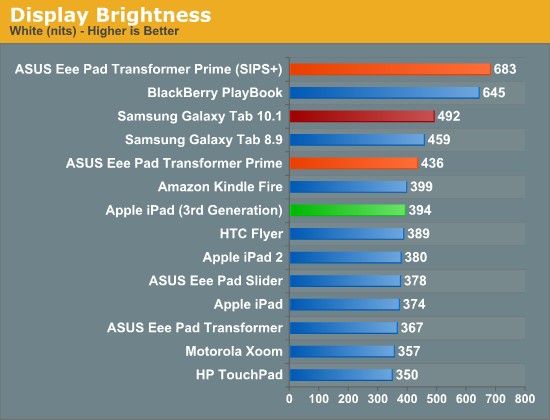
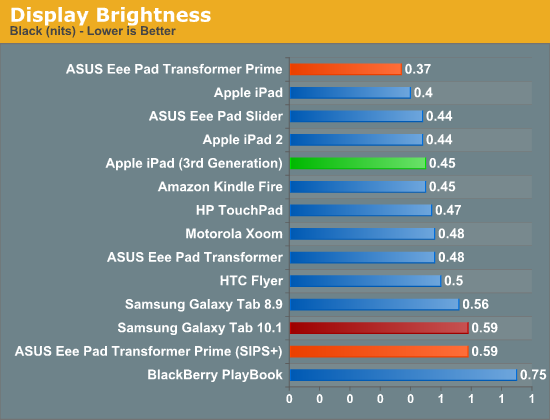
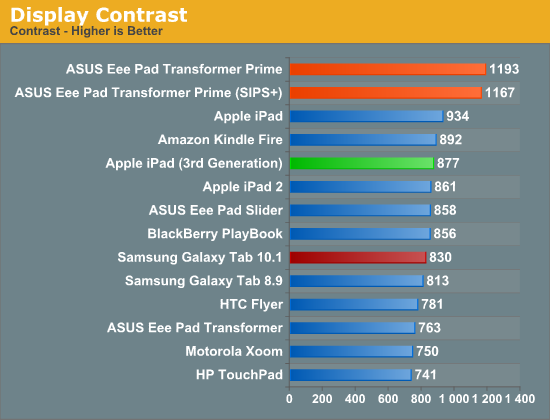
Apple is expected to have triple sourced panels for the new iPad, so you can expect to see variation in these results but for the most part you can expect the new iPad's display to perform similarly to the previous model.
Despite similar brightness and contrast to the previous model, the new iPad offers remarkably better color gamut and color reproduction than its predecessor. Relative to other tablets, the iPad's display is spectacular.
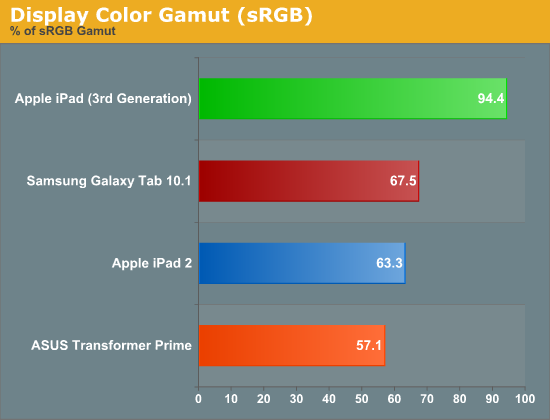
As we mentioned in our Retina Display analysis, Apple delivered on its claims of a 44% increase in color gamut. The new iPad offers nearly full coverage of the sRGB color space and over 60% of the Adobe RGB gamut:
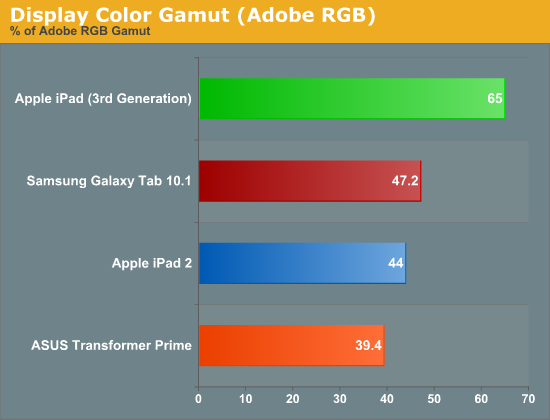
Below is the CIE diagram for the new panel with an sRGB reference plotted on the same chart so you can visualize the data another way:
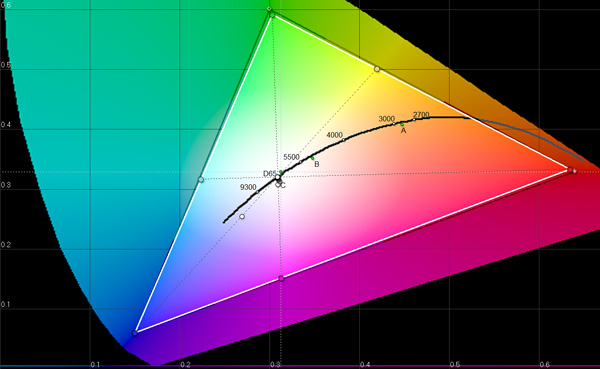
Color accuracy has improved tremendously if we look at delta E values for the primary and secondary colors:
Remember from our display reviews, lower delta E values indicate greater color accuracy. Values below 4 are typically considered good and you can see that the iPad 2 as well as the Transformer Prime both fell short in this department. With the new iPad Apple has clearly focused on color accuracy, which makes sense given it was used as the vehicle to introduce iPhoto for iOS.
Apple still has a lot of work ahead of itself to really put forth a professional quality display in a tablet, but for now the Retina Display is easily the best we've seen in a tablet and a tremendous step forward.
What's most absurd about the iPad's Retina Display is that you're able to get this resolution and panel quality in a $499 device. While we must be careful not to give Apple too much credit here as Samsung, Sharp and its other display partners clearly make the Retina Display, it's obvious that Apple has really been pushing its partners to develop solutions like this.
The biggest problem in the production of any commoditized component is the primary motivation for innovation is to lower cost. For years I argued with notebook PC makers to use higher quality LCD panels but no one was willing to commit to the quantities that would lower costs enough. I was also told that as soon as you put these notebooks on shelves at Best Buy, users wouldn't really care whether they were getting a high quality IPS display or not—all that mattered was the final price.
Apple, under the leadership of Steve Jobs, had a different mentality. Steve's pursuit was quality and experience, cost was a secondary concern. Through slow and steady iteration of this approach, Apple was able to build up a large enough customer base and revenue to be a significant force in the industry when it came to driving costs down. Apple can easily fill your fabs and eat all that you can produce, but you'll have to do whatever it wants to get the order.
Apple's behavior since it got rich has been to drive down the cost of higher quality components, LCDs being a perfect example. Unfortunately other companies don't benefit as much here as Apple tends to buy up all of the production of what it has pushed to create. That's one reason why, although ASUS was first to introduce a 1080p Transformer Pad, it won't launch until well after the new iPad. From what I've heard, the panel makers are all busy servicing Apple's needs—everyone else comes second.
Eventually the entire industry will benefit and all indications point to Apple doing something special for "pro" users in the notebook space next. As I've said previously, Apple has raised the bar with the iPad's Retina Display. The time for average display quality in a $500 tablet is over, the bar has been raised. It remains to be seen whether or not Apple will be able to maintain this quality across all suppliers of its Retina Display. On the iPhone Apple has been entirely too lax about maintaining consistency between suppliers. If it wants to be taken seriously in this space Apple needs to ensure a consistent experience across all of its component vendors.

















234 Comments
View All Comments
sjael - Wednesday, March 28, 2012 - link
On the 'A5X vs Tegra 3 In the Real World' page, you mention Modern Warfare 3 as a iOS+Android game.I think, since I haven't seen this game ported to phones/tablets, you *might* be thinking Modern Combat 3.
And then of course you show the market page for it further down..
Anand Lal Shimpi - Wednesday, March 28, 2012 - link
Correct - thanks for the heads up!Take care,
Anand
Celestion - Wednesday, March 28, 2012 - link
Looks like the 3rd gen iPad was CPU limited in that first GlBenchmark test.Anand Lal Shimpi - Wednesday, March 28, 2012 - link
That would be vsync :)Take care,
Anand
Celestion - Saturday, March 31, 2012 - link
I see. Thanks!Kevin G - Wednesday, March 28, 2012 - link
Memory bandwidth tests just seem to be off for what you'd expect a quad channel 128 bit wide memory bus to perform as. Performance didn't move from the dual channel 64 bit wide bus in the iPad 2. Could there be a software bug (Geekbench or iOS) limiting performance there? It'd be nice to revisit the memory tests after the next major revision of iOS and in conjunction with a later release of Geek Bench.Any chance of getting the exact resolution that Infinity Blade 2 runs on the rev 3 iPad? I'm assuming it'd be either 1536 x 1152 or 1368 x 1024 for quick scaling purposes.
slashbinslashbash - Wednesday, March 28, 2012 - link
They addressed this in the article."It would appear that only the GPU has access to all four channels." - Page 12
The GPU is hooked up to the RAM controllers. The CPU communicates to the RAM through the GPU. The GPU gets all 4 channels, the CPU only gets 2. The benchmark measures CPU-RAM bandwidth, not GPU-RAM bandwidth.
It's actually kind of interesting, as it's an inversion of the typical architecture that we're all used to from PCs. But it makes sense, since the new iPad is basically a very nice screen with a smartphone CPU attached. The very nice screen requires a very nice GPU to drive it, so the GPU is more important (and would be memory starved with only 64 bits). The CPU just has to be "good enough" while any shortcomings in the GPU would be magnified at this resolution.
tipoo - Wednesday, March 28, 2012 - link
Which way is the PS Vita configured? That has the same quad core GPU and a quad core CPU as well.tipoo - Wednesday, March 28, 2012 - link
Huh, the Vita actually has 128mb dedicated video memory, can't find the bandwidth though.pickica - Monday, April 2, 2012 - link
We should also consider a possible higher clock on Vita.